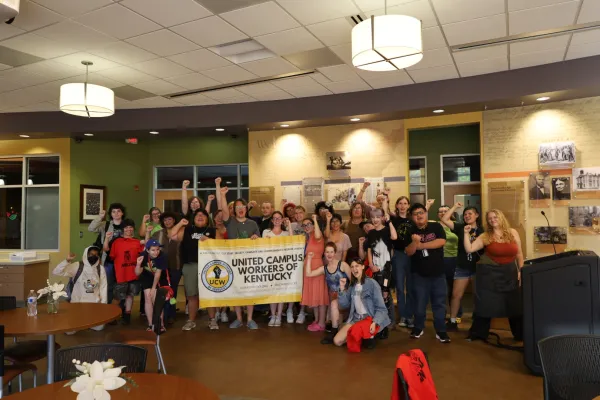Campus workers in the right-to-work South are fighting for COVID-19 conditions and beyond
This story originally appeared in Scalawag.
For a moment, it seemed like the COVID-19 crisis may have opened our collective eyes to what really matters, and that perhaps we would see a shift in national priorities. We saw people caring for one another by wearing masks and social distancing, helping neighbors apply for unemployment insurance, and organizing tenants unions; and we saw essential workers lauded for their important and heroic contributions to our society.
But the shock of the pandemic has worn off, and workers—both those deemed essential and those not—are now being nearly ignored. And without any mandates or guidance from the federal government: states, businesses, and people have begun to go back to business as usual. This includes universities, which unfortunately can expect many instances of “superspreading,” thanks to dorms, dining halls, classes, and parties. But in the right-to-work South, campus workers are fighting back by organizing for safe working conditions—and for power in their workplace, beyond the pandemic.
The four states with the lowest rates of union density in the country are South Carolina, North Carolina, Virginia, and Texas—and it is no surprise that workers in these states earn lower wages and have fewer rights at work than workers in states with high union density.
Most states in the South have right-to-work laws, which labor organizers and union supporters often refer to as “right to work for less” laws. These laws ban union security agreements between employers and unions, meaning that unionized workplaces are prohibited from requiring all workers to pay union dues. Right-to-work laws make unions weaker and smaller, and are common in the South because of the region’s legacy of slavery and Jim Crow—and the continued division of Black and white workers. The four states with the lowest rates of union density in the country are South Carolina, North Carolina, Virginia, and Texas—and it is no surprise that workers in these states earn lower wages and have fewer rights at work than workers in states with high union density. Collective bargaining for all public sector employees is also illegal in Virginia and the Carolinas. Additionally, Southern states are dealing with higher rates of coronavirus infection and death, making the lack of protection and power for workers even more terrifying.
But just because unions are rare in the South doesn’t mean workers throughout the region aren’t constantly resisting—university workers are organizing across the region for COVID-19 safety in spite of the institutional and structural barriers. And while universities are often exceptionalized and revered for their prestige, what actually goes on inside their halls can tell a different story: skyrocketing tuition that’s putting millions into debt, dismal working conditions and low wages, alongside bloated, bureaucratic administrations.
The pandemic has put many of the universities’ shortcomings into focus, prompting its workers to take action. According to Chris Huebner, the co-chair of the Duke Graduate Students Union (DGSU) and a Ph.D. student in English, COVID-19 and its repercussions are “definitely an opportunity for us. It’s never been clearer that the university doesn’t care about the people it employs, whatever position they’re in on campus, and is really just interested in exploiting workers to continue to collect tuition.”
At Duke University, DSGU, which is affiliated with Service Employees International Union (SEIU) Southern Region Local 27, brought members together for an emergency meeting in mid-March, and coalesced around an initial set of demands.
In the spring, campuses quickly shuttered in response to the growing threat of the novel coronavirus. Faculty and graduate workers who had only ever taught in person were forced to immediately pivot to virtual learning. Many educators felt unprepared to make the switch, but did their best for their students, all under the extreme stress of a pandemic and a brewing recession. This scramble and panic happened on top of consistent low wages for adjunct faculty, pay caps for graduate workers, and resources allocated more to building new dorms and dining facilities than to empowering educators and teaching students.
Over the summer, academic workers wondered what would happen in the fall—would campuses open, or would they continue remote education? They waited to hear from university administrators, hoping that they would make a decision in the best interests of both students and staff. But the siren song of full tuition was too strong for university leaders, ignoring public health researchers and other experts in order to bring in as much money as possible. This meant that faculty and graduate workers were left in the dark for months, and most had no legitimate avenue to voice concerns about reopening—they were forced to wait for a decision to be made for them. Now, many universities have been open for a few weeks, and some have experienced large COVID-19 outbreaks. Students have been blamed for partying, and some even dismissed for breaking social distancing rules—while universities have held onto their full tuition payments.
At Duke University, DSGU, which is affiliated with Service Employees International Union (SEIU) Southern Region Local 27, brought members together for an emergency meeting in mid-March, and coalesced around an initial set of demands. While the union is not formally recognized by the Duke administration, their “direct-action, direct-join” model has allowed them to score real victories, including extended family leave, tuition covered for six years instead of five, and a guaranteed stipend increase in 2022. Their initial pandemic-related demands were mostly focused on funding concerns, like trying to get guaranteed summer funding for all graduate workers over this past summer, with the hope of leveraging that into a permanent guarantee of summer funding.
If schools do go back to remote learning because of COVID-19 spikes, some educators feel like they didn’t receive enough support to improve their virtual instruction—that administrators were too busy pretending everything was normal to actually prepare them for the reality they’re faced with.
According to Huebner, “the university’s response was pretty disappointing… there’s this predatory insistence by administrators that because educators deeply care about teaching and our students, they can take advantage of us.”
Now that most universities are in a hybrid model, with part-in person and part-digital instruction, many wonder if schools will cancel on-campus classes and transition back to 100 percent remote instruction due to COVID-19 outbreaks. In the meantime, graduate workers at Duke are relying on the good will of their department chairs and individual faculty to allow them to work from home, but workers without good relationships with their immediate bosses could be out of luck as they wait for a university-wide decision to be made. If schools do go back to remote learning because of COVID-19 spikes, some educators feel like they didn’t receive enough support to improve their virtual instruction—that administrators were too busy pretending everything was normal to actually prepare them for the reality they’re faced with.
Marion Rust, a Professor of English at the University of Kentucky and Editor of early American Literature, told Scalawag that “there’s less focus on ‘this is what we have to do and now let’s teach people how to do it well,’ and more on ‘how do we keep this pipe dream alive.’” Rust joined United Campus Workers of Kentucky, a direct join union affiliated with Communications Workers of America (CWA) fairly recently, because she “wanted to work with graduate students, staff, all levels and facets of the university—not just in the narrow focus of my College of Arts and Sciences.” Even though their union is not recognized by the administration, the members of UCW-Kentucky have already scored some major victories, like pushing the university President to cut his salary, and getting the school to provide free COVID-19 testing for any campus worker.
The situation that university workers are in now encapsulates the larger issues plaguing academia—structural problems that existed well before the COVID-19 pandemic, like unstable, low wage employment and lack of focus on giving educators the tools they need to be successful— both stemming from a lack of worker power.
And it’s not just faculty and graduate workers who are organizing. In the face of COVID-19, DGSU has partnered with other unions and workers’ groups on campus to create Duke Workers United, which also includes adjunct faculty, bus drivers, housekeepers, groundskeepers, and dining workers. They are fighting for safer working conditions, paid time off, and a “seat at the table” so that they can have a say in decisions made about the university and their role in it.
Charles Gooch, a chief steward at AFSCME Local 77, told Scalawag that the Duke Workers United coalition is absolutely necessary in the face of the COVID-19 pandemic. “Administration doesn’t want us to be together, because when we come united, we stand stronger. They don’t want us talking to each other.”
Gooch, who has worked at Duke for 46 years as a food-service worker, makes less than $18 an hour, and is concerned that the university isn’t being transparent with him and other service workers about the very real threat they face. Gooch said “Most of the white collar workers are still at home. Only the service workers are on campus.” It’s too unsafe for the highest paid administrators to be on campus, but it’s perfectly fine for the lowest paid workers to keep schools running—this is the logic of the for-profit university, which puts their bottom line over workers’ health.
The situation that university workers are in now encapsulates the larger issues plaguing academia—structural problems that existed well before the COVID-19 pandemic, like unstable, low wage employment and lack of focus on giving educators the tools they need to be successful—both stemming from a lack of worker power. Many see this moment—the pandemic and its related economic crisis—as a catalyst to radically alter our institutions, and to create new ones. Universities could look like places of shared learning, where the workers who make them run are truly respected, with the pay and union rights to prove it. Or they could continue to be run like businesses, with staff health and safety as the university’s lowest priority.
But of course, all of that is up to campus workers themselves, and how hard they decide to fight. Rust told Scalawag that “union organizing is alive and well in the right-to-work South.” If she and other campus organizers have anything to do with it, workers will use this crisis as an opportunity to change universities for the better—permanently.
Berea College agrees to 'sick leave' policy for student workers

